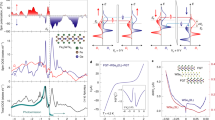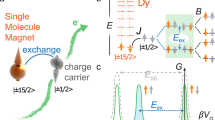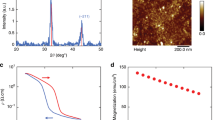Abstract
The new paradigm of electronics, ‘spintronics’, promises to extend the functionality of information storage and processing in conventional electronics1. The principal spintronics device, the ‘spin valve’, consists of two magnetic layers decoupled by a spin-transporting spacer, which allows parallel (on) and antiparallel (off) alignment of the magnetizations (spins) of the two magnetic layers. The device resistance then depends on the spin alignment controlled by the external magnetic field. In pursuit of semiconductor spintronics2, there have been intensive efforts devoted to develop room-temperature magnetic semiconductors3 and also to incorporate both inorganic semiconductors4 and carbon-based materials5,6,7,8,9,10,11 as the spin-transporting channels. Molecule/organic-based magnets, which allow chemical tuning of electronic and magnetic properties, are a promising new class of magnetic materials for future spintronic applications12,13. Here, we report the realization of an organic-based magnet as an electron spin polarizer in the standard spintronics device geometry. A thin non-magnetic organic semiconductor layer and an epitaxial ferromagnetic oxide film were employed to form a hybrid magnetic tunnel junction. The results demonstrate the spin-polarizing nature of the organic-based magnetic semiconductor, vanadium(TCNE: tetracyanoethylene)x (x∼2; Tc∼400 K), and its function as a spin injector/detector in hybrid magnetic multilayer devices.
This is a preview of subscription content, access via your institution
Access options
Subscribe to this journal
Receive 12 print issues and online access
$259.00 per year
only $21.58 per issue
Buy this article
- Purchase on Springer Link
- Instant access to full article PDF
Prices may be subject to local taxes which are calculated during checkout




Similar content being viewed by others
Change history
23 July 2010
In the original version of this article published online and in print, the received date should have been 29 December 2009, not 2010. This has been corrected in the PDF and HTML versions of this Letter.
References
Wolf, S. A. et al. Spintronics: A spin-based electronics vision for the future. Science 294, 1488–1495 (2001).
Awschalom, D. D. & Flatté, M. E. Challenges for semiconductor spintronics. Nature Phys. 3, 153–159 (2007).
Dietl, T., Ohno, H., Matsukura, F., Cibert, J. & Ferrand, D. Zener model description of ferromagnetism in zinc-blende magnetic semiconductors. Science 287, 1019–1022 (2000).
Appelbaum, I., Huang, B. & Monsma, D. J. Electronic measurement and control of spin transport in silicon. Nature 447, 295–298 (2007).
Tombros, N., Jozsa, C., Popinciuc, M., Jonkman, H. T. & van Wees, B. J. Electronic spin transport and spin precession in single graphene layers at room temperature. Nature 448, 571–574 (2007).
Hueso, L. E. et al. Transformation of spin information into large electrical signals using carbon nanotubes. Nature 445, 410–413 (2007).
Dediu, V., Murgia, M., Matacotta, F. C., Taliani, C. & Barbanera, S. Room temperature spin polarized injection in organic semiconductor. Solid State Commun. 122, 181–184 (2002).
Xiong, Z. H., Wu, D., Vardeny, Z. V. & Shi, J. Giant magnetoresistance in organic spin-valves. Nature 427, 821–824 (2004).
Shim, J. H. et al. Large spin diffusion length in an amorphous organic semiconductor. Phys. Rev. Lett. 100, 226603 (2008).
Santos, T. S. et al. Room-temperature tunnel magnetoresistance and spin-polarized tunneling through an organic semiconductor barrier. Phys. Rev. Lett. 98, 016601 (2007).
Yoo, J-W. et al. Giant magnetoresistance in ferromagnet/organic semiconductor/ferromagnet heterojunctions. Phys. Rev. B 80, 205207 (2009).
Miller, J. S. & Epstein, A. J. Organic organometallic molecular magnetic materials — designer magnets. Angew. Chem. Int. Ed. Engl. 33, 385–415 (1994).
Prigodin, V. N., Raju, N. P., Pokhodnya, K. I., Miller, J. S. & Epstein, A. J. Spin driven resistance in organic-based magnetic semiconductor V[TNCE]x . Adv. Mater. 14, 1230–1233 (2002).
Tengstedt, C., de Jong, M. P., Kanciurzewska, A., Carlegrim, E. & Fahlman, M. X-ray magnetic circular dichroism and resonant photoemission of V(TCNE)x hybrid magnets. Phys. Rev. Lett. 96, 057209 (2006).
Kortright, J. B., Lincoln, D. M., Edelstein, R. S. & and Epstein, A. J. Bonding, backbonding, and spin-polarized molecular orbitals: Basis for magnetism and semiconducting transport in V[TCNE]x∼2 . Phys. Rev. Lett. 100, 257204 (2008).
Caruso, A. N. et al. Direct evidence of electron spin polarization from an organic-based magnet: [FeII(TCNE)(NCMe)2][FeIIICl4]. Phys. Rev. B 79, 195202 (2009).
De Fusco, G. C., Pisani, L., Montanari, B. & Harrison, N. M. Density functional study of the magnetic coupling in V(TCNE)x . Phys. Rev. B 79, 085201 (2009).
Matsuura, H., Miyake, K. & Fukuyama, H. Theory of room temperature ferromagnet V(TCNE)x (1.5<x<2): Role of hidden flat bands. J. Phys. Soc. Jpn 79, 034712 (2010).
Manriquez, J. M., Yee, G. T., Mclean, R. S., Epstein, A. J. & Miller, J. S. A room-temperature molecular/organic-based magnet. Science 252, 1415–1417 (1991).
Zheludev, A. et al. Experimental determination of the spin density in the tetracyanoethenide free radical, [TCNE]−, by single-crystal polarized neutron diffraction. a view of a π* orbital. J. Am. Chem. Soc. 116, 7243–7249 (1994).
Pokhodnya, K. I., Epstein, A. J. & Miller, J. S. Thin-film V[TCNE]x magnets. Adv. Mater. 12, 410–413 (2000).
Haskel, D. et al. Local structural order in the disordered vanadium tetracyanoethylene room-temperature molecule-based magnet. Phys. Rev. B 70, 054422 (2004).
Tengstedt, C. et al. Coulomb interactions in rubidium-doped tetracyanoethylene: A model system for organometallic magnets. Phys. Rev. B 69, 165208 (2004).
Schmidt, G., Ferrand, D., Molenkamp, L. W., Filip, A. T. & van Wees, B. J. Fundamental obstacle for electrical spin injection from a ferromagnetic metal into a diffusive semiconductor. Phys. Rev. B 62, R4790–R4793 (2000).
Sato, O., Tao, J. & Zhang, Y. Z. Control of magnetic properties through external stimuli. Angew. Chem. Int. Ed. 46, 2152–2187 (2007).
Yoo, J-W. et al. Multiple photonic responses in films of organic-based magnetic semiconductor V(TCNE)x, x∼2. Phys. Rev. Lett. 97, 247205 (2006).
Yamada, H. et al. Engineered interface of magnetic oxides. Science 305, 646–648 (2004).
Park, J-H. et al. Direct evidence for a half-metallic ferromagnet. Nature 392, 794–796 (1998).
Park, J-H. et al. Magnetic properties at surface boundary of a half-metallic ferromagnet La0.7Sr0.3MnO3 . Phys. Rev. Lett. 81, 1953–1956 (1998).
Tsymbal, E. Y., Mryasov, O. N. & LeClair, P. R. Spin-dependent tunnelling in magnetic tunnel junctions. J. Phys. Condens. Matter 15, R109–R142 (2003).
Acknowledgements
We thank J. S. Miller and K. I. Pokhodnya for initial collaboration and their help in developing V(TCNE)x film. This work was supported in part by AFOSR Grant No. FA9550-06-1-0175, DOE Grant Nos DE-FG02-01ER45931, DE-FG02-86ER45271, DE-FG02-06ER46327, NSF Grant No. DMR-0805220 and ONR Grant No. N00014-07-1-0215.
Author information
Authors and Affiliations
Contributions
J-W.Y., V.N.P. and A.J.E. wrote the manuscript. J-W.Y. and A.J.E. worked on device characteristics, data collection and analysis. J-W.Y. and C-Y.C. did device fabrication. C-Y.C. did CVD growth for V(TCNE)x films and synthesis for the precursors of V(TCNE)x. H.W.J., C.W.B. and C.B.E. prepared epitaxial LSMO samples with LAO capping. All authors discussed the progress of research and reviewed the manuscript.
Corresponding author
Ethics declarations
Competing interests
The authors declare no competing financial interests.
Supplementary information
Supplementary Information
Supplementary Information (PDF 999 kb)
Rights and permissions
About this article
Cite this article
Yoo, JW., Chen, CY., Jang, H. et al. Spin injection/detection using an organic-based magnetic semiconductor. Nature Mater 9, 638–642 (2010). https://doi.org/10.1038/nmat2797
Received:
Accepted:
Published:
Issue Date:
DOI: https://doi.org/10.1038/nmat2797
This article is cited by
-
A scalable molecule-based magnetic thin film for spin-thermoelectric energy conversion
Nature Communications (2021)
-
Research progress of rubrene as an excellent multifunctional organic semiconductor
Frontiers of Physics (2021)
-
Half-Metallic and Half-Semiconductor Gaps in Cr-Based Chalcogenides: DFT + U Calculations
Journal of Superconductivity and Novel Magnetism (2019)
-
Organic-based magnon spintronics
Nature Materials (2018)
-
A coronene-based semiconducting two-dimensional metal-organic framework with ferromagnetic behavior
Nature Communications (2018)



